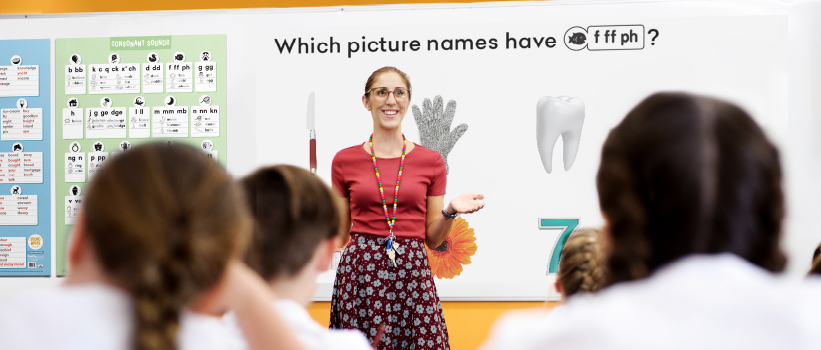Articles & Videos
Victorian schools adopt explicit instruction of systematic synthetic phonics – Sound Waves Literacy is here to help!
Categories
Subscribe to our newsletters
Receive teaching resources and tips, exclusive special offers, useful product information and more!
Back to Product Features articles & videos
Victorian schools adopt explicit instruction of systematic synthetic phonics – Sound Waves Literacy is here to help!
Sound Waves Literacy 27/6/24

Victoria has joined the wave that’s rolling across Australian education as the Education Minister, Ben Carroll, mandates for all Victorian public schools to implement the explicit instruction of systematic synthetic phonics from 2025.
The move is backed by a wealth of research and puts a focus on improving reading outcomes across the state. Carroll’s aim is to ensure ‘every child from any background can read fluently.’
For Victorian educators, it’s all systems go towards this evidence-based approach to literacy instruction. Curriculum leaders and teachers on the search for practical and effective solutions are faced with finding the training and resources required to set their schools up for success.
Let’s break down how Sound Waves Literacy covers all bases.
Systematic synthetic phonics
Sound Waves Literacy uses a systematic synthetic phonics approach to teaching spelling and reading. It’s systematic because it follows a carefully controlled order of introduction for graphemes and it has a cumulative Scope and Sequence that progresses from simple to more complex concepts. The synthetic phonics approach means students are explicitly taught phoneme–grapheme relationships and how to segment and synthesise (blend) phonemes for spelling and reading.
While the program uses systematic synthetic phonics as its base, it also covers phonemic awareness in the early years and shifts to building students’ morphological awareness and etymological knowledge as students move through the upper years.
Explicit instruction
All of the instruction in Sound Waves Literacy is designed to be clear and direct to facilitate explicit teaching. There is no expectation for students to implicitly pick up or discover reading and spelling. Lessons use the Gradual Release of Responsibility pedagogy and provide teachers with carefully structured lesson guides and interactive slideshows for every phoneme–grapheme relationship and focus concept taught across F–6. Lessons include opportunities for teachers to check for student understanding and culminate in independent practice for students to consolidate knowledge.
Evidence-informed and aligned to the Science of Reading
Sound Waves Literacy is an evidence-informed program based on findings from peer-reviewed research and reviews from the fields of education, psychology and linguistics on the best practices for reading and spelling instruction. This includes the interdisciplinary research of the science of reading which provides evidence for the cognitive processes that underpin the development of children’s oral language, reading and writing skills. For research links, read our detailed article Sound Waves Literacy and synthetic phonics: The facts.
The Victorian Curriculum
The Sound Waves Literacy program comprehensively covers the Phonics and word knowledge sub-strand of the Victorian Curriculum v2. View the Victorian Curriculum Match v2 for more information.
Reading instruction using Decodable Readers
Reading and spelling are intrinsically linked. As such, Sound Waves Literacy includes targeted reading instruction in the early years’ lessons through the use of Decodable Readers.
Sound Waves Decodable Readers are short texts that only contain the phoneme–grapheme relationships students have been explicitly taught in the program’s sequence. These books give students specific opportunities to apply their phonemic awareness and knowledge of phoneme-grapheme relationships, which over time leads to quick and accurate word recognition.
For each focus phoneme taught in the Foundation and Year 1 sequence, there is a Support, Core or Extended Decodable Reader to choose from. Having differentiated decodable texts means every student can experience reading success.
Free professional learning
The Sound Waves Literacy team has a wealth of teaching experience and offers a range of tailored professional learning opportunities to continually support schools to effectively use the wide range of teaching and learning resources. Whether your school wants an introduction to systematic synthetic phonics, a deep dive into segmenting skills or tricky graphemes, or a focus on effective early reading instruction – there’s a workshop option to suit your needs. Contact your local Education Consultant to book a workshop for your school today.
A whole-school approach
While the recent announcements by the Victorian Department of Education have focused on the implementation of the new Teaching and Learning Model from Foundation to Year 2, schools should implement a whole-school solution right through to Year 6 in accordance with curriculum requirements. The Sound Waves Literacy whole-school approach ensures students are given consistent, sequential and cumulative instruction as they progress through their primary school years. This provides a nested platform for students to revise and build on their phoneme–grapheme knowledge each year, which extends to morphology and etymology as the program progresses. A whole-school approach also provides benefits to teachers, as they can plan, report and share best practice more cohesively.
Ready to take the next step? Start exploring the Sound Waves Literacy resources with a 30-day free trial.